Edutainment
Indian comics that you should know about
There was a time when comic books were the easiest way of entertainment and publications made sure that they were full of fun and adventures to keep children hooked. However, with digitalisation came a period which was so bad for existence of comic books that more than 50 publications shut down.
Published
8 years agoon
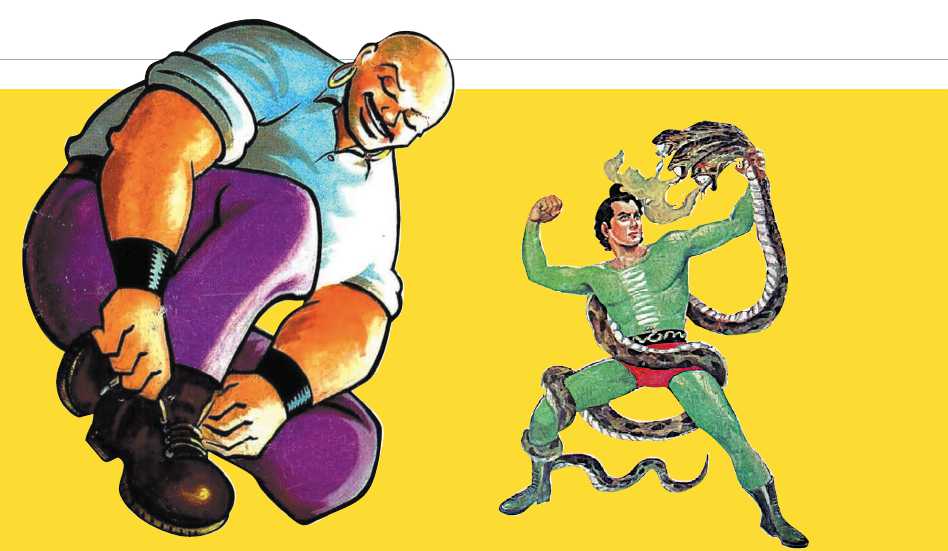
There was a time when comic books were the easiest way of entertainment and publications made sure that they were full of fun and adventures to keep children hooked. However, with digitalisation came a period which was so bad for existence of comic books that more than 50 publications shut down.
Once upon a time there lived a generation which enjoyed reading those thin colorful books with illustrated graphics. That was the best thing a child could do during hot summer afternoons. Those books were their friends in long journeys, at home and an ally during study. The companionship was strong. Characters of these books illuminated something within and made sure every child lived the funny side of life, turned adventurous in his own way and forayed into a magical world that these books presented. This was the time when comic books were at their best. They were welcomed by parents and children alike. Not only were they presented as a treat but some brands also held higher opinion over others.
They took the children in the fantasy world of colorful characters which were strong and wanted to save the world and gripped them with their exemplified graphics and exciting story line. It was the time when Indian super heroes were born and were read by children all over; a time that gave wings to every child’s imagination, taking them not only around the planet earth but also to different galaxies.
1990’s was the time when comic books were the easiest way of entertainment and publications made sure that they were full of fun and adventures to keep children hooked. However, with digitalisation came a period which was so bad for existence of comic books that more than 50 publications shut down. Videogames and later computers and mobiles took away the spell the comics had on children. There are few comics which are still published or are worth reading from the archives that will be talked about in this article.
The first name that clicks when comic books are mentioned is that of legendry cartoonist Pran. He made sure that children get all cuddling and fun experiences of life through colorful comic books and with Diamond Comics; he gave birth to an era where comics were treated like prized possessions. They were traded for latest or past issues, collected as souvenirs and cherished forever.
They were the best entertainment a child could get while growing up. Let alone children, even grown-ups sought out the latest editions as soon as they were out. On one hand where there were characters like ‘Billoo’ and ‘Pinki’ who represented young boys and girls, at the same time there were characters like ‘Raman’, ‘Shrimati Jee’ and ‘Channi Chachi’ which represented the adults. The equation and the balance of every character suited the scenario. They fit in perfectly amongst developing India. Whether it was a middle class employee or a modern housewife or a naughty teenager, the comics ensured that nothing was beyond the child’s comprehension.
Today while talking about comics it would be unfair if we leave Pran and his evergreen creations for the last. Let us relive some characters that were cherished by children while growing up during the golden era of comic books.
Chacha Chaudhary:
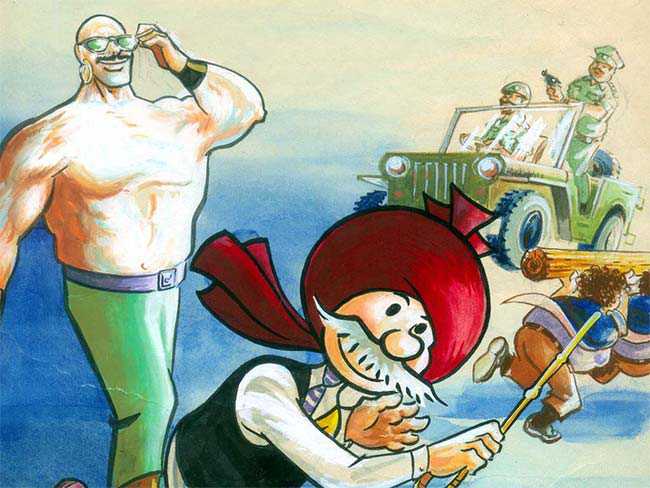
“Chacha Chaudhary’s brain works faster than a computer.” Every child knew this legendary line by heart. Nobody can forget the elderly man ‘Chacha Chaudhary’ who with his wit was able to solve all the complications that were thrown at him. Such was his fame that later he was personified on television too.
His companion ‘Sabu’ was every child’s dream as it was believed that he was a real resident of Jupiter and the most powerful man on planet earth. The children craved for their character to win over all other villains like ‘Raka’ and ‘Gabbar Singh’.
The not so designer but lovable dog ‘Rocket’, his nagging wife ‘Binni Chachi’ and an old truck Dag-dag which was half machine and half human made sure that all the essence of a middle class family was present. The comic was even personified on small screen by actor Raghuveer Yadav.
The show has made five hundred episodes and used to run on ‘Sahara One’. It is the first Indian cartoon character which was brought on screen. Chacha Chaudhary’s wit and Sabu’s strength could master even the most difficult situations in no time and that’s what made this duo the most loved. There was one such situation which came in front of Sabu when he was playing Cricket and a character ‘Datuk’ who although hated cricket called him for a match. He also added his condition of playing with his own ball.
While Sabu goes back home to collect stumps, a passerby reveals that his ball was made of stone and he just want to break his bat and want to have some fun. Meanwhile when Chacha Chaudhary finds Sabu taking only stumps from home and leaving the ball behind he asks Sabu the reason for doing so. After hearing Datuk wants to play with his ball, Chacha Chaudhary asks him to take a different bat which Sabu does. When Datuk bowls Sabu it was welcomed by a smacking shot and ball break hitting Datuk in return. It was then Chacha Chaudhary was shown speaking, “If he can bowl a stone ball we can also play with a steel bat.” Such incidence made him the master of wit and delivered a clean and refreshing entertainment which adorned every kid’s book shelves.
Billoo:
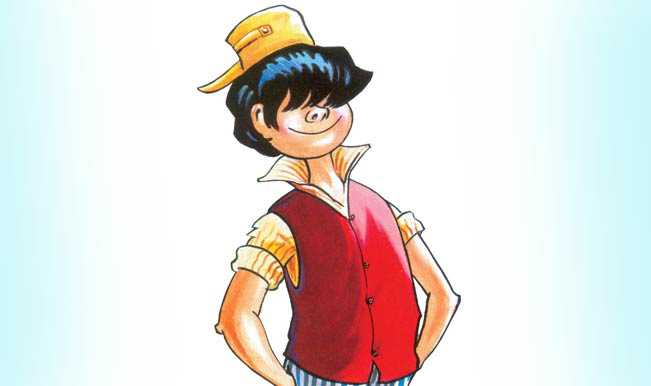
Billoo was shown as a naughty school going teenager who is mischievous and who gets in trouble due to his pranks. He is a lovable character and along with his pet pup Moti he has few more members like Gabdu, Jozi, and Monu etc. His hairstyle is shown such that the hair covers his forehead and eyes all the time and nobody has seen them so far. A character of a clever teenager who loves to play cricket connected with almost every boy of that generation and thus gained popularity in no time.
To add to the challenge we had Bajarangi a cunning wrestler and his side-kick Dhakkan who are constant trouble creators. Billoo and his gang detest them completely. Initially comic books had shown Billoo as a kid however later his character developed as a teenager, in one of his comics it was shown that Jozi, his childhood friend becomes his girlfriend.
Pinki:
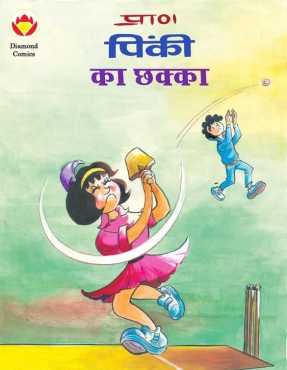
Pinki is shown as a kid and is created by Cartoonist Pran Kumar Sharma. She is shown as a five year old kid and is extremely naughty. So much so that entire neighborhood is scared of her mischievous nature. She is always shown with her pet squirrel kut-kut who is equally naughty and completes the duo with similar energy. Constant characters of her comic books were her friends Bhiku and Champu and her neighbor Jhaptji who is shown as the most common victim of Pinki’s mischief.
Every episode where Pinki is shown to help Jhaptji ends up with him being in trouble and lots of laughter. Pinki is otherwise a lovable kid with a pure heart. In one such episode, it was shown that her pet kut-kut chewed away someone’s car’s tyre. The owner angrily tells her that she will have to compensate. Our beloved Pinki cutely asks him if she could give him another tyre in return. When the owner agreed, she ran back home and brings her toy car’s tyre saying innocently that her squirrel also bit only a little of the whole tyre. Her natural quaintness came because of her age. She for all the reason became one of the favored comic characters of the lot.
Raman:
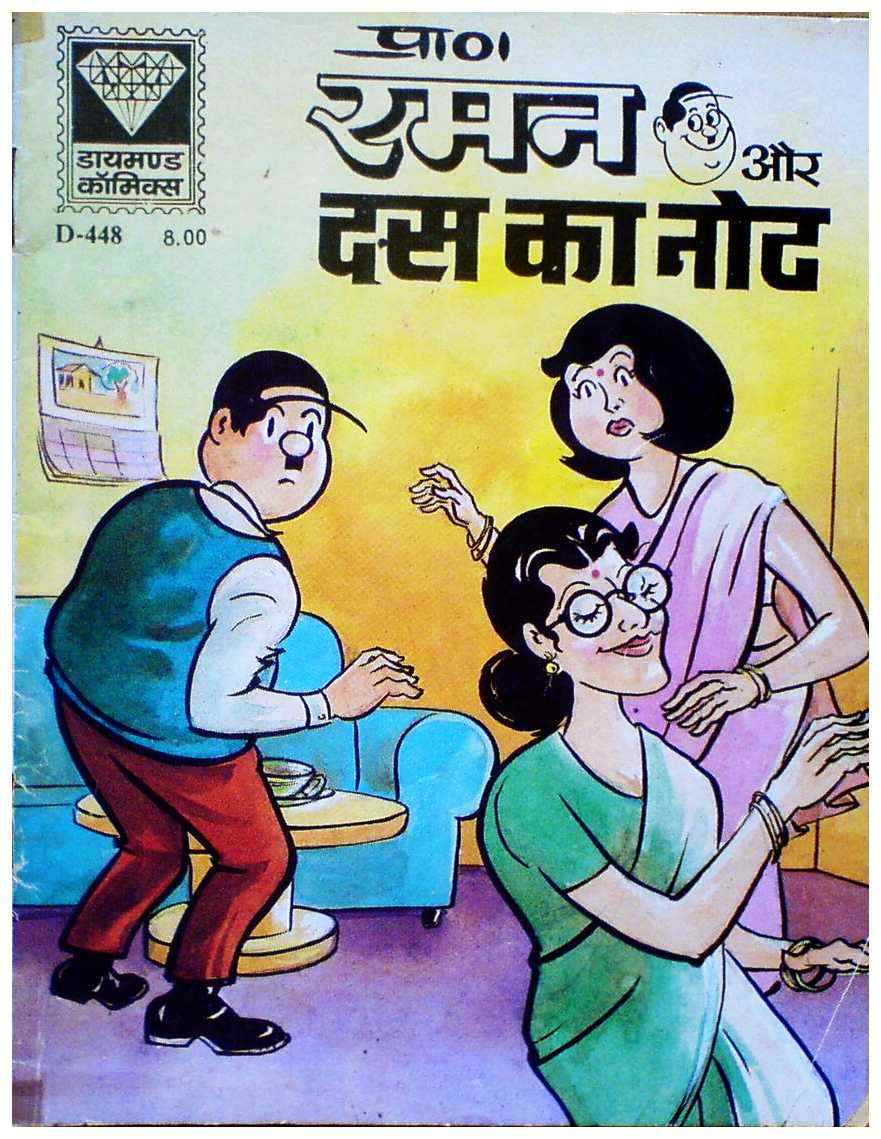
Raman was a middle class office executive who was yet again a milestone creation of Cartoonist Pran. His character was released by the then Prime minister Late Smt. Indira Gandhi. Raman is shown having two friends Moga Singh and Khaleefa – a Sikh and a Muslim. Together they stand representing three main religions that dominate India. The essence of Raman is to make people realize that laughter is important while working hard to gain our achievements. Raman through his comic books lived the situations close to the common man and expressed his comfort/discomfort/opinion through the same.
Shrimati Jee:
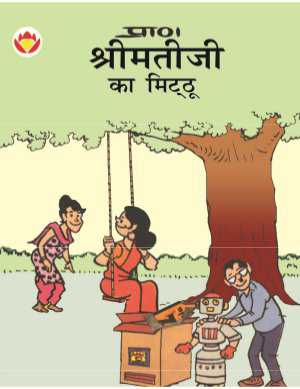
Sheila or Shrimati Jee as she was called in the title was a character dedicated to middle class Indian women and was first published in Sarita, which was a women oriented magazine. It soon got a massive female fan following as it mostly covered situations that a normal Indian women would go through, whether it is about price rise or problems with kids or issues with husband or that with kitty parties etc.
Shrimati Jee lived it. She was mostly shown with her husband Kishore. The issues talked in the comic were very common and funny. In one such episode, Kishore was shown taking leave from work and glued in front of the TV to watch some cricket match (a very common household scenario). From the kitchen Shiela aka Shrimati Jee, calls him for breakfast, he requests her to serve him his breakfast there only as he did not want to move away from TV.
She willingly does it. Then after a while she reminds him that he needs to get a haircut. To this, he makes a phone call to the barber and calls him home to get a haircut in front of TV. Irritated, she tells him to take a bath after getting the haircut to which he sighs and wishes for the water to come to him so he needn’t leave his match. Angry as a bull she is shown bringing a water hosepipe in the drawing room and drenching him saying, “Here it is.” Totally hilarious, such situations happen to most women and we all have lived it someday or the other. Many such small instances were covered in the cartoon which made it a regular feature in Manorama, another women magazine.
Apart from Diamond Comics, Raj Comics were another famous name which kept the torch burning even during tough times. Characters crafted by this group were more of action figures and superheroes. Most of them fought criminals and goons to save the earth from destruction. Some comics that were immensely successful were:
Super Commando Dhruv:
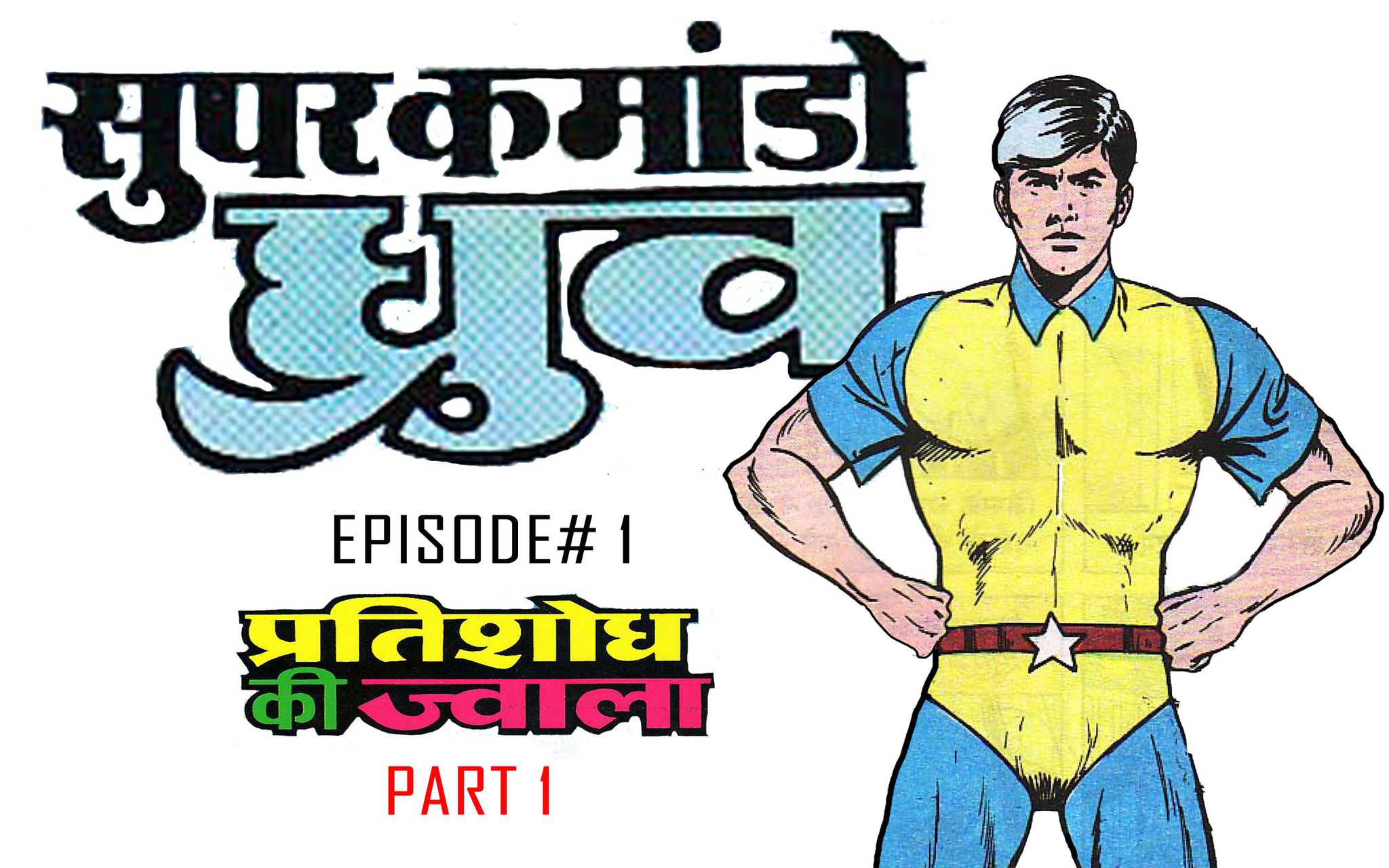
Dhruv Mehra or Captain Dhruv as he is called by his Commando Force is a fictional character created by Raj comics. He is shown as a normal boy who grows up and trains himself so well that he possessed many skills like speaking to most birds and animals and an expertise in martial arts. He is a stunt biker and a master of acrobats. He gets it from his parents who were workers in Jupiter Circus which plays in the fictional city of Raj Nagar. His name literally means pole star and just like the celestial body, he is strong and adamant on his decisions.
The best part about Dhruv is that he does not have any alter ego. There is no mask or appearance that he pulls in front of rest of the world. People know who he is and what he is capable of doing. Another thing that makes Dhruv different is that he has no superpowers; however his dedication towards his work has made him a master of all trades. He has learned almost all kinds of martial arts and is master in hand to hand combat.
Also, he is an expert marksman and has a very strong sixth sense. He is also the leader and founder of a fictional government ‘Star Commando Force’ which aims to diminish crime from the world. In one of his adventures Swarn Nagri came in existence. It was shown located under water hidden in a way that it could not be found by human eyes. It was shown occupied by Swarn Manas or the Deva. A Swarn Warrior Dhananjay was introduced who at first fought Dhruv but later he befriend him and gave him the ability to breath underwater for 20 odd minutes. In the same issue, Natasha was introduced who became Dhruv’s love interest. With changing time and in line with the demand of readers, Dhruv was shown in more sci-fi fictions; he was shown fighting and saving the world from bigger threats like Aliens and mad scientists. Even during the dark ages of comics, Super Commando Dhruv was one of few comics which kept on being published and loved by the fans. Irrespective of all the powers and extra abilities, Dhruv was shown as down to earth and a humble person who respects elders and is well mannered. It was also shown that he loves his foster family more than anyone in the world. He has high value for human life and prefers to submit criminals to judiciary rather than killing them.
Nagraj:
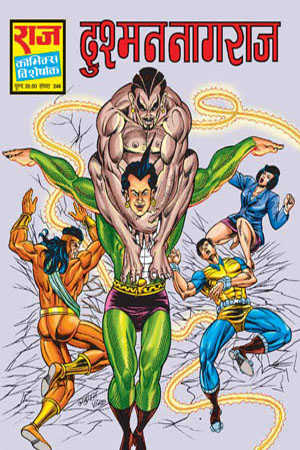
Nagraj was yet another blockbuster creation of Ra Comic books which touched the youth and climbed the ladder of favorites. Nagraj as the name says means king of snakes and was evolved from the myth of Ichchadhari Naga that is shape changing snakes. In his debut comic, he was shown being used by wicked Prof. Nagmani who wanted to use it as terror weapon against humans for his benefit.
In his debut comic he was controlled by Prof. Nagmani and was asked to steal a golden statue of a goddess which was secured by her devotees, snakes and a mystic Gorakhnath who was said to be 300 years old. Although Nagraj succeed in stealing the statue initially, he was then defeated by Gorakhnath and his mongoose Shikangi. Gorakhnath reads his mind and comes to the conclusion that he was being puppet by Prof. Nagmani through a mind controlling device which was implanted in his head. After realizing this, Gorakhnath removes the device and sets him free. In return Nagraj becomes his disciple and vows to remove crime from earth. Since then Nagraj has been moving around defeating villains and terrorists. He lives as an alias of Nagraj Shah (Raj) and works as a TV channel employee. He is even shown having a secretary.
Nagraj comics have a perfect mix of fiction, mythology, sci-fi and magic which takes them closer to both adults and children. Mysterious life and myths that rotate around snakes makes it more intriguing raising Nagraj to greater heights of popularity. His superpowers include him being ageless and having superhuman strength which developed and increased as the character evolved. He also had quick healing and is an expert martial artist. His acute sixth sense, skills of a hypnotist and his psychic power made him stand out from others. His other attributes could be connected with other similarities that snakes share like poison bite, venomous breath, skin shedding. Some of his powers were given to him keeping mythology in mind which talked about shape shifting snakes. Most of his power comes from the millions of microscopic shape shifting snakes which live in his blood. Nagraj just like Super Commando Dhruv has survived the worst times for comic books and has been loved throughout.
Bankelal:
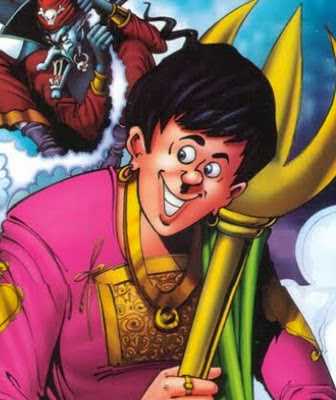
He is a comic character who is always shown in search of some way through which he could kill the King Vikram Singh and take over the throne. At the start of every comic book, he discovers some secret or important information surrounding which he designs his schemes. However, every time by the end of the comic his scheme backfires and King Vikram Singh gets profited. By the end of every comic book readers are left laughing. Bankelal was given the appearance of a not so good looking man. He has a small Charlie Chaplin kind of moustache and buckteeth.
Bankelal is shown as the adoptive son of ‘Nanku’ who’s a farmer and his wife ‘Gulabati’ who is a homely lady and a devotee of Lord Shiva. Bankelal has been portrayed as a super notorious child. So much so, that in one story it was told that once when Lord Shiva and Goddess Parvati visited his home and his mother offered them milk; Bankelal put a frog in the milk. This enrages Lord Shiva and he cursed him that in future if he ever tries to do any harm to anybody, his plan will backfire rather benefitting the victim. In doing so he will also get benefitted a little. His curse works in favor of King Vikram Singh which saves him from Bankelal’s trick gaining him more wealth with every experience.
Doga:

He is probably the most famous antihero of Indian comic books. His existence comes as an orphan infant found in the rubbish dump by dacoit Halkan Singh and he used him as a shield to save himself from the Police. After taking the child with him in his den he treated him like a dog (He even named him kutte) and made him witness horrors of life. Somehow he escapes his captivity with another girl Sonu who was kidnapped by the dacoit. Late he was shown getting in touch with four brothers i.e. Adrak Chacha, Dhania Khan, Haldi Khan and Kali Mirch Khan the owners of the Lion Gym and seeing his devotion they let him train under them.
Vigorous training gave him lots of muscles and strength. He also learned martial arts, boxing and marksmanship. He took the identity of Doga and wore a dog mask. His image is that of a one man army and he vows to remove organized crime. He is shown working mainly in Mumbai. His love interest is Monika who is the daughter of Inspector Cheetah, a retired police officer and a private detective.
Bhokal:
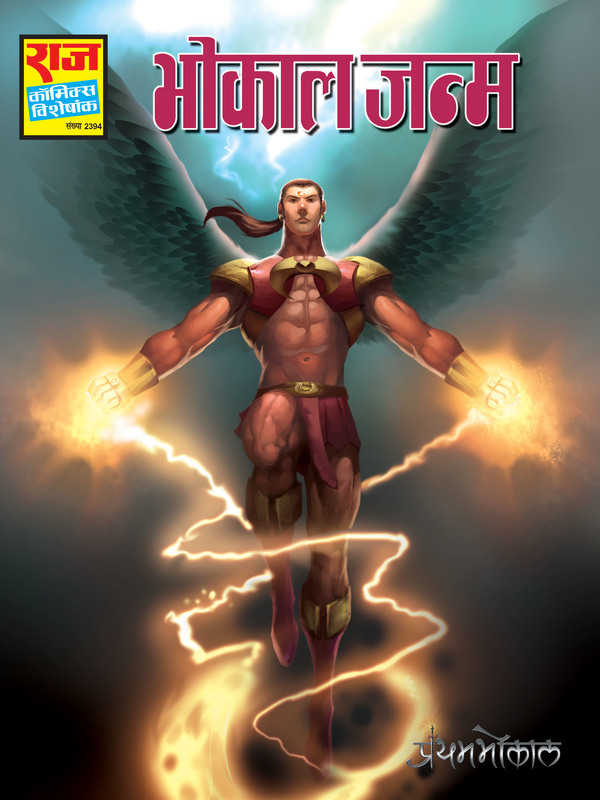
He is a warrior prince descended from the fictional land of Pari Lok. His real name is Alop. He has come to yet another fictional town Vikasnagar on planet earth with the intension of taking part in a fighting tournament. He has superhuman strength and is a skilled swordsman. He also has a shield which helps him block any natural or supernatural attack. The shield also allows Bhokal to fly to his desired destination. His love interest was Turin, a princess from another planet. She later becomes his wife. She also has a shape shifting pet cat which can fly.
Parmanu:

A school going boy Vinay witnesses his classmate getting killed by some criminals and vows to revenge her death. He finds out that the head of police was behind this all. He finds out that the murder weapon a revolver and is chased by goons of the police head who wants him dead. However, his uncle, a professor K.K Verma saves him and shares his secret costume which when worn can give Vinay a lot of superpowers. He wears it and kills his enemies along with the head of police. His costume provides him with many atomic superpowers which include atomic rays, teleportation and shrink rays.
Tinkle:
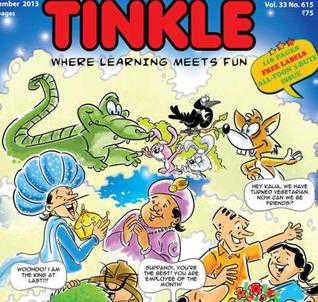
With the tagline ‘Where learning meets fun’ Tinkle meets every child’s expectation by being a complete package consisting of stories, comics, puzzles and quizzes. It has been an important part of developing India and its readership included many adults too. It had an intoxicating mix of stories and children columns and provided the perfect blend of education and entertainment. Characters like Suppandi and Shikari Shambhu, Tantri the mantri and Kalia came to fame riding Tinkle’s shoulders.
Suppandi is one of the most famous character of Tinkle who is a simple villager whose ignorant but faithful attitude costs him many jobs. In one such strip a postman comes to deliver a letter for Suppandi and he being an illiterate asks him to read it for him. While he was reading it, Suppandi runs and covers the postman’s ears. When he was questioned for his action, he simply replied, “This part of the letters concerns my family business and I don’t want you to hear it.” In another one he was shown asking a blind beggar for his proof of blindness. When he told him that he cannot see the tree which Suppandi can see, this simpleton believes him and gives him alms while feeling sorry for him. His stupidity or lack of understanding left sreader chuckling every time.
Shikari Shambhu got his title ‘Shikari’ (hunter) from the fact that he once fell on a tiger while trying to hide from him which made him unconscious. People thought that the tiger was captured because of his bravery and hence he has given the title. In reality Shikari Shambhu is a fearful hunter who rather lives life lazily. In most of his episodes, he tries to run away from dangerous animals but somehow ends up capturing them and becoming a hero. This character is always shown wearing a hat so big that it covers his eyes and curvy black moustaches. He is also shown carrying a large rifle which he has never used properly.
Another character which was a regular in Tinkle was Kalia the crow. He has his friends Keechu and Meechu (the rabbits), Shonar (a deer) and Babloo (a bear). Apart from these there are Chamataka (a jackal) who is also the main baddie of the jungle who is either after rabbits or other small animals or after Babloo’s honeycombs. Kalia with his intelligence is shown saving everyone from Chamataka. Chamataka also has a best friend Doob Doob (a crocodile) who is a little dumb and despises Kalia. Many times it was shown that Kalia fools Doob Doob to save the rabbits. Lubdubi is Doob Doob’s girlfriend and it is his dream to fly some day.
Nasruddin Hodja was another creation of Tinkle which made its way to the reader’s hearts through his wit and cheeky ideas. He has many enemies, who try to put him down, however, Hodja with his smartness gets out of the situation turning the tables on his haters.
Madhu Muskan:
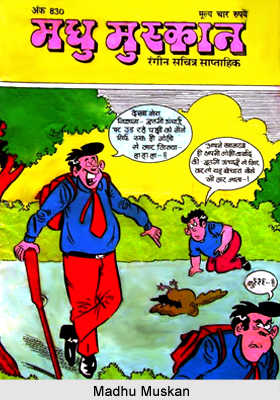
Madhu Muskan was a humorous magazine where most of its characters were designed to make people laugh. The central character was ‘Daddy Ji’ who remained part of this comic book for almost 25 years. He was the poster boy for every Madhu Muskan issue. He was shown as self boasting who kept botching every situation. He was the kind of character who can be found in every family. Daddy and his son Jojo who is shown as the main source of Daddy Ji’s plight was another important character of the plot.
Sometimes he teamed up with his friend Headache, which does justice to his name when adding Daddy ji’s misery. Simple day to day life was portrayed between father and son. In one such front page Daddy Ji was shown brushing teeth and Jojo was telling him that he has taken his toothbrush to apply grease on his cycle. Daddy jee is shown as complete foodie. A typical Punjabi who loves non-vegetarian and loath any kind of diet. Some of Madhu Muskan’s covers made fun of his attitude towards food too.
At one place he was shown freaking out while reading Dr. Bhatnagar’s prescription where he was asked cut his diet to two chapattis a day and a bowl of yellow dal in his lunch, whereas Jojo is shown smirking on his situation adding to his misery by further describing that dal should be without salt and chapattis without ghee. Many such situations were added to make the character everyone’s favorite. Another character in Daddy Ji was Malik sahib who was his boss and a miser. He was shown as a Punjabi speaking man who adorned a flower above his ear.
Popat-Chopat:
It was another loved cartoon of Madhu Muskan. The characters were the Indian version of Laurel and Hardy. Popat is shown as fat with his tummy bulging out from his shirt and Chopat as the slim one of the two. In many episodes Popat entertained readers by cracking joke on his obesity. The 1974 New Year’s issue shows Chopat measuring Popat’s fat tummy saying every year there is an inch increment wondering what will happen to it in the year 2074. Malik Sahib is shown as their boss too.
Babloo:
Babloo, a teenage detective was famous for his valor and intelligence in solving mysteries. It was shown that his uncle is a superintendent of police and he always looked forward to taking his help in solving cases.
Daku Pan Singh, as per the name this character was famous for his goodness and his love for pan where he gets immense strength after chewing on a pan. He is shown as a risk taking and fearless dacoit.
Amar Chitra Katha:

As per records it is said to be one of India’s largest selling book series. It was created keeping the most basic thing in mind – to teach students more about Indian history and cultural heritage. The books were published under different genres. There were Fables and Folklores under which Panchtantra comes. :ike Aesop Fables, it used different animals and their natural characteristics, teaching human behavior and psychology. Stories like the ‘Thirsty Crow’, ‘The Lion and the Rabbit’, ‘Foolish Crocodile’ etc not only entertained children, but also left them with a lesson to learn.
Next was Mythology where children were given information about stories that build Indian culture whether it was Ramayana or stories of Krishna, Tales of Shiva or any other God and demon. Amar Chitra Katha brought it to every child’s shelf and explained with ease all that was to be known.
The Epics was the genre under which stories like Mahabharata, Heroes of Hampi etc. were published. It was easier to make students understand the complication of Mahabharata through illustrated comics than telling them in the form of a story. For parents too, it was a good way of keeping children busy.
Another genre which Amar Chitra Katha provided was Humor and Wit and The Biographies. Under these segments books like Birbal and Mahatma Gandhi were published. In short Amar Chitra Katha picked up the torch of educating children with aspects which were left untouched otherwise. It used the most loved medium to do the honor and needless to say that it is has been immensely successful. Keeping itself updated Amar Chitra Katha evolved and launched its free mobile app for Windows, iOS and Android phones where users can browse their favorite book from the archive and can also access the upcoming editions. There are both free and paid comics that users can either read in the app or can download on multiple devices using same account.
Lot Pot:
Lotpot was best known for its characters Motu and Patlu. They were friends with their physical appearance more or less like Popat Chopat but were much more popular among the masses. Motu as the name says was fat amongst the two and Patlu, resembling his name was the slim one. They were simple people with a heart of gold but are shown getting caught up in silly plots tickling the readers. Motu is also shown as an avid samosa fan as a samosa provides him with instant power. Their gang consisted of Ghasitaram who’s pet dialogue in every complicated situation being, “I have twenty years of experience of solving it.” Dr. Jhatka who is scientist and loves experimenting and inventing different gadgets, however none of his inventions are useful and most of the time Motu Patlu gets caught in trouble due to his funny inventions. Chelaram who was another funny member of the group his physical appearance consist of buckteeth which makes him stand out. Motu Patlu became so famous that in the year 2012 an animated series was developed which was an instant hit. There were some character additions in the animated series, namely Inspector Chingam, John the thief, Chaiwala (samosewala), boxer etc. The series just like its comics, was a big hit among children and adults.
Chandamama:
It was a monthly magazine which was present in most households. It was best known for its artwork and published long running stories full of mythology and magic. It had a very different approach towards story telling. It kept the suspense going taking cues from various Indian and foreign texts.
It has published a very successful and never ending story of Vikram and Baital in which King Vikramaditya was given a task by Vamachari – a tantric disguised as a sage to bring Baital ( a pishach) for a religious practice. It was a difficult task which Vikramaditya vowed to fulfill. Every time Vikram captures Baital, he offers to tell a story with a promise that he will not speak or interfere in between. Baital always finishes a story with a question and asks Vikram to solve it for him threatening him every time that if he stayed quiet even after knowing the answer then he will face heavy consequences. Vikarmaditya was known for his valor and for his truthfulness, each time he is shown solving the riddle and Baital leaving him to go back to his resting place. Next issue starts from the start with Vikramaditya recapturing Baital to take him along with.
Champak:
Champak was a fortnightly magazine which was very popular amongst children. It was published in both a magazine style and comic strips. Many of its stories just like Panchtantra took animals as their muse and taught children different things in simple ways. It also started a story writing competition for children below 12 years which was judged by novelist Chhaya Singh and Vinay Kumar. Annual writing and painting competition held by Champak has been named ‘Champak Creative Childs Contest.’
Comic books lived as a family member of every child who grew up in the 90’s and still remain fresh in their memory. Today when Indian Comic books are either on their way of digitalization, or have lost their charm, it is for us to help them survive by introducing them to our children. Today’s generation prefers watching cartoons on television rather than sitting and reading comics. They do not understand the thrill one feels while reading and the places our brain travels while reading. Irrespective of the odds, many comics in the race for survival have digitalized themselves and have their websites or Apps from where reader can access to the content. Now it is our job to let them get past our devices so our little ones too can live the enchanted world we accessed.
This article was originally published in the May 2017 issue of ScooNews magazine. Subscribe to ScooNews Magazine today to have more such stories delivered to your desk every month.
You may like
-


Less Than Half of Indian Schools Offer Skill-Based Courses for Senior Students: NCERT Survey
-
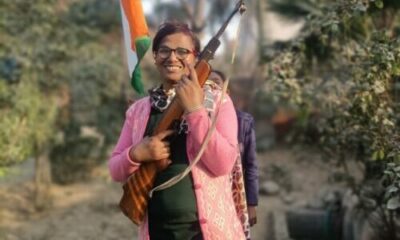

The Woman Who Refused to Disappear – Aditi Sharma’s Quiet Fight for Education
-
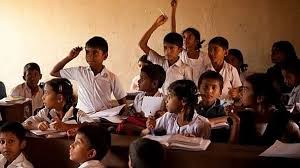

UP Govt Launches Astro Labs in Government Schools to Boost Scientific Learning
-
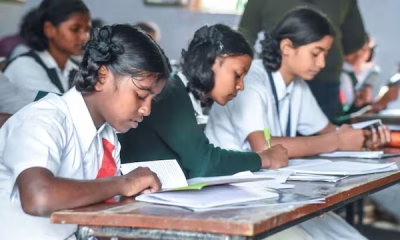

Class 3 Learning Levels Show Gains Since Pandemic, But Still Below 2017: PARAKH Survey
-


Manipur Rallies Call for Disruption-Free Education Amid Ongoing Unrest
-
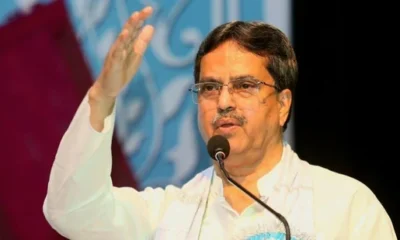

Tripura CM Launches School Framework, Stresses Social Work in Education
-
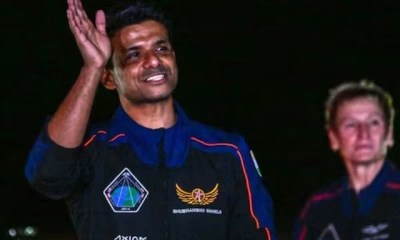

“We Sleep on Walls Here”: Shubhanshu Shukla Talks to Indian Students from Space
-


A Structural Proposal to Transform School Education in Bihar
-


NIIT Foundation and YuWaah, UNICEF Launch Free Online Digital Marketing Course for Youth
-
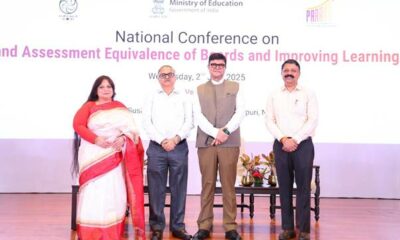

National Conference Pushes for Common Standards Across School Boards
Edutainment
Of Formulas and Frames: Why India Must Stop Dividing Science and Art
Published
1 month agoon
June 10, 2025
In a recent interview with Lallantop, Varun Grover—acclaimed writer, lyricist, comedian, and filmmaker—hit upon a truth so striking, it should’ve been plastered across school walls: India has lost its plot in nurturing innovators. And the reason? We’ve boxed our subjects—and our students—into separate lanes. Science on one side, art on the other. One wears lab coats, the other paints canvases. They rarely, if ever, meet.
Grover put it sharply: in India, we’ve created a caste-like hierarchy between subjects. Science students often carry the burden of “doing real work,” while arts students claim the higher ground of exploring life and meaning. The result? A deep-rooted disconnect. And it begins early—often in Class 11, when students are forced to pick a stream and silently abandon the rest of their interests.
But must a physicist give up poetry? Must a musician ignore algorithms?
It doesn’t have to be this way. At MIT, one of the world’s top science and tech universities, PhD students in Physics can take courses in music, design, or history—and earn credits for them. Why? Because innovation thrives where disciplines intersect. Because understanding how a flute works can teach you more about frequencies than a textbook diagram ever will.
Consider Steve Jobs, who credited a college calligraphy class for inspiring the Mac’s typography. Or Indian innovator Sonam Wangchuk, whose work in Ladakh seamlessly blends engineering with local art, architecture, and sustainability. His Himalayan Institute of Alternatives (HIAL) teaches future engineers and designers side-by-side, breaking the very silos our system has normalised.
Even Nobel laureate Richard Feynman once said, “I have a friend who’s an artist… He’ll hold up a flower and say, ‘Look how beautiful it is,’ and I’ll agree. But I can also see beauty in how the flower works—its structure, its physics. Science only adds to the beauty.”
And yet, in India, we continue to teach these as separate things. We train students to clear tests, not to create. We push them into IIT-JEE coaching at 13 and expect them to build world-changing ideas at 25.
This isn’t just an academic issue—it’s cultural. Our textbooks rarely reference architecture as both engineering and aesthetic legacy. Our school plays and science exhibitions are held in different corners of the building. Our awards are either for “Best Innovation” or “Best Performance”—never both.
The irony is painful. A land of classical music rooted in maths. A civilisation that built temples with astronomical precision. A country that once integrated dance, sculpture, and geometry with everyday life. And yet, we’ve chosen to modernise by compartmentalising.
It’s time we remember what Varun Grover reminded us of: the pyramid is both an engineering feat and an artistic marvel. And so is the human mind.
Let’s build an education system that stops asking children to choose between knowing and feeling, between numbers and narratives.
Let’s stop making them pick a lane—when the real magic happens at the crossroads.
Education
World Environment Day: Why Your School’s Environmental Education Needs a Cleanup
Published
1 month agoon
June 5, 2025
It’s June 5. There’s a poster-making competition happening in the library. “Say No to Plastic,” one child writes, her glitter pen catching the sunlight. In the background, a teacher sips from a plastic bottle of mineral water. On the ground — a single dustbin, filled with half-eaten sandwiches, the plastic wrappers they came in, and the poster that didn’t win.
Welcome to World Environment Day. The annual ritual of colouring inside the lines of climate awareness, only to throw the sketch away at 3:00 p.m.
And nowhere is this performance of eco-consciousness more apparent than in the average Environmental Studies (EVS) class. A subject that, in theory, is about the environment. In practice, it is about completing the syllabus before the assessments begin.
EVS is full of the right words: sustainability, waste segregation, reduce-reuse-recycle. It teaches children the parts of a plant, but not how to grow one. It tells them about carbon footprints, but not about the quiet pride of switching off a fan when they leave a room.
It is, in short, a subject that ends at the bell. Let’s pause and ask: how many schools actually segregate their waste? How many have separate bins for wet and dry garbage — not just during inspection week or annual day, but on a random Tuesday in August?
Most schools don’t have a waste problem. They have a waste denial problem.
Because admitting there’s a problem would mean someone has to do something about it. And doing something is messy. It requires time, training, tantrums. It requires telling people they can’t use fifteen thermocol plates for a two-hour workshop. It requires building a system where children see that the habits they are being asked to adopt are not just lesson objectives, but lifestyle choices being modelled by the adults around them.
Right now, most EVS classes are like that school function where the Chief Guest arrives in a diesel SUV to plant a sapling. Ceremonial. Shallow. Slightly offensive.
But here’s the good news: children get it. Better than we think. They’re not too young to understand why the cafeteria needs to stop using plastic spoons. They don’t need a unit on climate change to know that the AC doesn’t have to be set to freezing for learning to happen.
They just need one thing: to see the grown-ups walking the talk.
Start small. Set up separate bins — label them, colour-code them, talk about them. Let kids bring waste from home and run a sorting drive. Make a habit of auditing your school’s paper usage. Assign class monitors for turning off switches. Let kids design posters that don’t end up in the bin — or better yet, design the bins themselves. And while you’re at it, stop calling it an EVS period.
Call it the lab of life.
If you really want children to learn how to care for the world, don’t just teach them the names of forests. Teach them how to keep their classrooms clean. Don’t just mention Greta Thunberg in a chapter. Ask what they would skip school for. Don’t say “reduce-reuse-recycle” like it’s a rhyme. Say it like it’s a revolution.
And show them the bin.
Education
Children’s Bird Walks to Connect Young Minds with India’s Rich Avian Diversity
Published
5 months agoon
February 13, 2025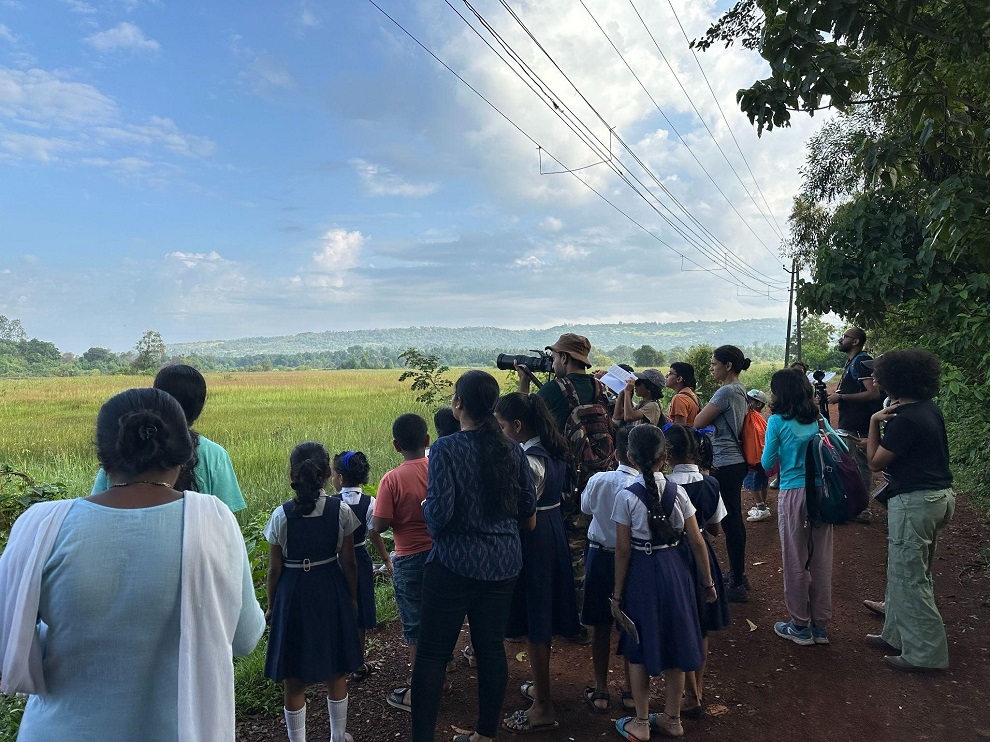
In an exciting initiative for young nature enthusiasts, Early Bird and Ataavi Bird Foundation are set to organise special bird walks for children during the Great Backyard Bird Count 2025. Scheduled for February 15th and 16th, 2025, these walks will take place in eight Indian cities: Bengaluru, Dimapur, Halol, Jaipur, Mangaluru, Ranchi, Trivandrum, and Ujjain.
Designed for children aged 9 to 13 years, the bird walks aim to nurture curiosity about birds and their habitats, providing an engaging introduction to birdwatching. Led by experienced nature educators, the sessions will help children identify different bird species, understand their behaviours, and develop a deeper appreciation for local biodiversity.
The Great Backyard Bird Count is a global citizen science initiative where birdwatchers of all ages observe and document bird species in their surroundings. The data collected contributes to worldwide studies on bird populations and helps scientists track migration patterns and conservation needs. This year, Early Bird is organising dedicated children’s walks as part of this initiative, encouraging young learners to explore nature firsthand.
Early Bird is a learning programme that brings children closer to birds and nature. The programme has impacted more than 3 lakh children throughout its 10-year existence. This is through the distribution of innovative educational materials on Indian birds, available in 10 Indian languages, besides English. Early Bird is a part of the Nature Conservation Foundation (NCF), a 28-year-old public charitable trust set up to contribute to the knowledge and conservation of India’s unique wildlife heritage.
Previous bird walks led by Early Bird’s expert educators have received enthusiastic responses. A parent from the Goa Walk 2024 shared, “Such an unbelievable and mesmerising variety of birds! Thank you for revealing these treasures in our everyday landscape!”
The event will take place at key nature spots in each city, including Avalahalli Lake (Bengaluru), Vadatalav Lake (Halol), Kishan Bagh Sand Dunes Park (Jaipur), and Akkulam Lake (Trivandrum). Partner organisations such as Coastal Karnataka Bird Watchers Network (CKBWN), Eco Warriors, Prakriti, and COCOON will collaborate to ensure an enriching experience for all participants.
Event Details
| City | Location | Partner Organisation | Date & Time |
|---|---|---|---|
| Bengaluru | Avalahalli Lake | – | 15 Feb 2025, 7:30 AM – 9:00 AM |
| Dimapur | PWD, Forest Colony Complex | Eco Warriors | 16 Feb 2025, 7:30 AM – 9:30 AM |
| Halol | Vadatalav Lake | COCOON | 16 Feb 2025, 7:30 AM – 9:30 AM |
| Jaipur | Kishan Bagh Sand Dunes Park | Prakriti | 16 Feb 2025, 7:30 AM – 9:30 AM |
| Mangaluru | NITK Campus, Surathkal | CKBWN | 16 Feb 2025, 7:30 AM – 9:30 AM |
| Ranchi | Jonha Park, Koynardih | Keystone Foundation | 16 Feb 2025, 7:30 AM – 9:30 AM |
| Trivandrum | Akkulam Lake | – | 16 Feb 2025, 7:30 AM – 9:30 AM |
| Ujjain | Triveni Eco Park | – | 16 Feb 2025, 7:30 AM – 9:30 AM |
How to Register
Registrations for the bird walks are now open. Interested participants can sign up at https://bit.ly/8cities8walks. Slots are limited and will be filled on a first-come, first-served basis.
This initiative provides a rare opportunity for students to engage with nature, learn about India’s diverse bird species, and contribute to an international conservation effort.
Edutainment
Word of the Year 2024: Can Teachers Keep Up With The Evolving Language of Gen Z?
Published
7 months agoon
December 9, 2024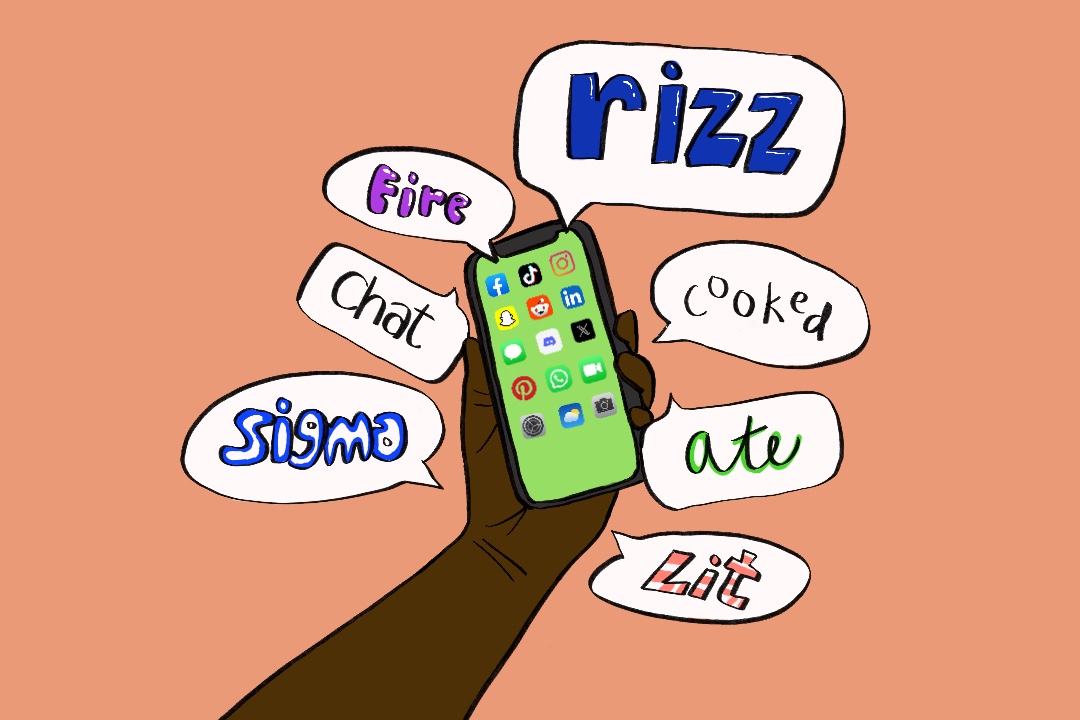
Language evolves at a rapid pace, and the younger generation—Gen Z and the emerging Gen Alpha—are taking it to new heights. Social media platforms like TikTok and Instagram have become hotbeds for linguistic innovation, where abbreviations, slang, and newly minted words emerge faster than ever before. Words like “brb,” “slay,” “sus,” and even Oxford’s Word of the Year 2024, “brain rot,” are part of their everyday vocabulary. But amidst this linguistic whirlwind, one question arises: Are teachers catching up?
A Gap in Communication
Imagine a classroom where a student says, “brb! Wanna use the washroom,” and the teacher pauses, unsure of the abbreviation. Such scenarios highlight a communication gap. Research consistently shows that effective communication between students and teachers fosters trust, engagement, and better learning outcomes. According to a 2022 study by Education Week, students who feel understood by their teachers are 45% more likely to excel academically and 30% less likely to skip classes.
However, understanding Gen Z’s and Gen Alpha’s linguistic trends isn’t just about learning a dictionary of slang—it’s about bridging a generational divide and fostering mutual respect.
Tackling the Language Gap
- Training Teachers on Evolving Language
One way to address the gap is to provide teachers with targeted training sessions that focus on the language trends of younger generations. These sessions could include decoding popular abbreviations, slang, and even cultural references that dominate social media. This approach can help teachers stay relevant and avoid miscommunication. However, with mounting academic and emotional responsibilities, many educators might find such training an added burden. - Building Relationships Through Interaction
A more organic solution lies in fostering better teacher-student relationships. By engaging in informal conversations with students, teachers can learn their language naturally. This approach not only helps teachers understand evolving slang but also humanises them in the eyes of their students, fostering trust and relatability. Interacting with students on their terms creates a classroom culture of mutual respect and understanding.
The Role of Language in Education
Language is more than just a tool for communication—it shapes relationships and builds cultural bridges. The words of the year like “manifest” and “brat” represent not only linguistic trends but also cultural shifts towards empowerment, individuality, and self-expression. Teachers who understand this language can better connect with their students, appreciating the unique values and pressures they face.
The Words of the Year 2024—‘brain rot’, ‘manifest’, ‘brat’, and ‘demure’—offer educators a glimpse into the psyche of today’s youth.
For example, ‘brain rot’ reflects Gen Z’s awareness of digital overconsumption, while ‘manifest’ underscores their optimism and drive for self-improvement. A teacher who grasps these nuances can integrate them into lessons and discussions, creating a more engaging learning experience.
Ultimately, understanding the language of younger generations is a two-way street. While teachers can make an effort to decode Gen Z and Gen Alpha slang, students too can adapt to bridge the gap. The key lies in fostering dialogue and mutual respect, ensuring that language differences become a point of connection rather than a barrier.
As language continues to evolve at a breakneck pace, the classroom must remain a space where both students and teachers feel heard and understood. By embracing change and prioritising communication, education can keep up with the times while maintaining its core values.
Edutainment
How Pop Culture is Making Reading Cool Again in Indian Classrooms: From Comics to Classroom Libraries
Published
10 months agoon
September 9, 2024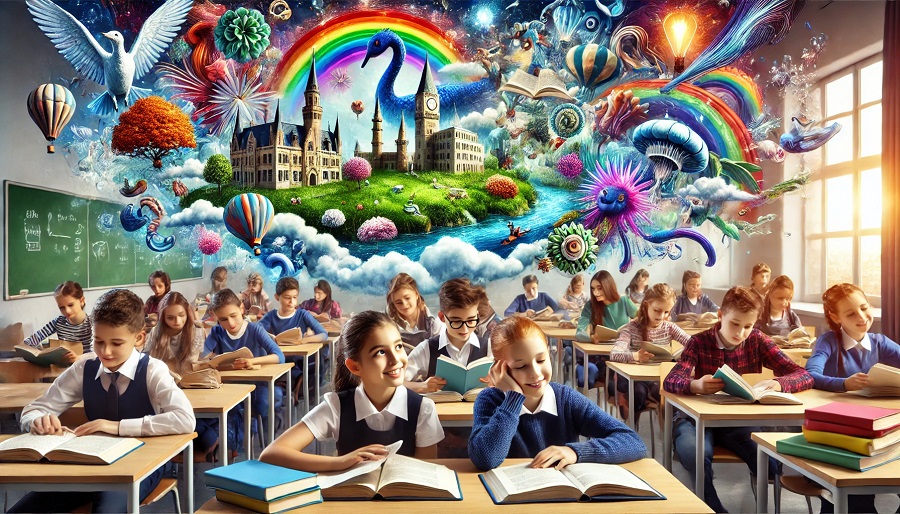
Alright, let’s be honest- reading was once that fun, interesting hobby of choice. There were children curled up with a book, immersed in the stories, dreaming themselves as warriors, magicians, or superheroes. However, at some point, reading became rather unpopular—children preferred binge-watching TV shows and spending hours on Instagram or TikTok rather than reading. But we see a light at the end of this tunnel, and it is glowing brighter with every passing day! It seems reading is cool again and we have pop culture to thank for it. From comics and graphic novels, fan fiction, and digital book platforms, literacy is going into the 21st century, and schools are slowly following (or at least attempting to).
And let’s begin with the simplest object possible—the so-called comics. Do you still recall how it was, when comics were considered as mere entertainment and could not be referred to as reading in any way? Well, news flash: they are now one of the most popular methods of making children read books once again. Whether it is Percy Jackson, Harry Potter or even Marvel and DC comics, children are fangirling/fanboying really hard for these narratives. Not only after school or in their leisure hours. And these stories are getting into classrooms as well. Schools have finally begun to acknowledge that comics and graphic novels can be as informative and engaging as the gigantic books that no one has any desire to open (and you know that that’s true).
School Libraries, which used to be dusty places with old and rarely read books, are now changing. Now, you can find shelves with graphic novels, books related to popular culture, and even manga! Schools are beginning to understand that if you put in the hands of children something fun and interesting, they will read it. Moreover, with visuals taking over every device we possess, it is only logical that children would be more attracted to books that have a strong visual component.
But it doesn’t stop there—teachers are getting creative too. Some schools have introduced events such as “Book Character Dress-Up Days” whereby children go to school dressed as characters from books and comic strips. Just think of an entire classroom filled with Percy Jacksons, Wonder Women, and Harry Potters—how cool is that? Not only is it a laugh but it also encourages imagination and creativity. Oh, and we desperately need that. Frankly, it is high time that schools stopped using the library period as an excuse for subject teachers to make up for lost time. Allow children to immerse themselves in stories, discover new worlds and think for themselves because if we do not, we are merely programming them to be little bookworms and robots. And that is a huge sign of trouble because innovation is the true power of the future.
Now, here’s the thing: we currently live in times when attention spans are shorter than ever and video content is massive. Children watch YouTube videos, Instagram stories, and TikToks every day, so it is a challenge to make them sit down and read a book. But that’s exactly why reading needs to be reimagined for this generation. The old paradigm of books and reading – curling up with a thick novel – just doesn’t work anymore. It is our imperative to introduce as much fun in reading as there is fun in the digital world children are so accustomed to.
Come other digital platforms such as Kindle, Scribblehub, Wattpad, and StoryWeaver. These platforms have made reading possible no matter where one is. Children are now avid readers of e-books, joining online reading groups, and even writing their own fan fiction. I mean, come on, how awesome is that? For instance, with Kindle, you have an entire library in the palm of your hand and that is something that appeals to today’s kids who are always attached to their gadgets. Rather than mindlessly scrolling through memes, they are swiping through pages of e-books, and that’s a victory in my book (literally).
Another massive factor in this reading revolution is the fan culture. Thanks to such platforms as Wattpad, children are not only reading; they are also writing! It means they are writing their own stories, posting them online where people from different parts of the world can read them, and interacting with other young writers. It is like having your own fan base and children are all about that now. Whether it is writing the sequels of their favorite TV shows or coming up with new fictional universes based on pop references, these children are redefining the concept of literacy. They are not passively reading stories, they are actively constructing them.
In essence, literacy is not just a process of learning to read and write but also involves the ability to read and write for a purpose. It is about participation, cognition, and imagination. But come on, the method of teaching and learning literacy cannot be the same as what is used in schools. We can no longer simply depend on the traditional ways of doing things. The world is dynamic and so is reading, which is a very important aspect of learning and knowledge acquisition. If the goal is to raise readers for life, and thinkers as well- then it is imperative that reading remains relevant. And thanks to pop culture, it seems that we are on the right track.
So, here’s to the schools that are waking up and smelling the coffee. To the teachers who are using pop culture to make literacy cool again. And to the kids who are picking up comics, joining digital book clubs, and writing their own stories. Because in a world dominated by technology, reading is not only the art of survival, but the art of success.
Education
Embracing Emojis in the Classroom: A Fun and Polite Approach to Modern Learning
Published
12 months agoon
July 18, 2024
Today, on World Emoji Day, let’s celebrate these small, expressive icons that have become an integral part of our digital communication. While some argue that emojis threaten the sanctity of language, there’s a fun, quirky side to these tiny pictures that can actually enhance classroom interactions, making them more relevant, polite, and engaging.
Remember the thrill of getting a gold star on your homework? That star wasn’t just a sticker; it was a symbol of achievement, recognition, and encouragement. In many ways, emojis serve a similar purpose. They convey emotions and reactions succinctly and can add a personal touch to written communication. So, why not harness the power of emojis to make our classrooms more dynamic and student-friendly?
1. Enhancing Feedback: Traditionally, teachers use phrases like “good job” or “well done” to praise students. But imagine the added excitement if those words were accompanied by a clapping hands emoji 👏, a star ⭐, or even a trophy 🏆. Such visual cues can amplify the impact of positive feedback, making it more memorable and encouraging for students. Conversely, gentle reminders can be softened with a thoughtful emoji. For instance, a neutral face 😐 or a thinking face 🤔 could be used to indicate that a student might need to revisit a particular concept without causing undue stress or discouragement.
2. Encouraging Polite Communication: Emojis can also help maintain a polite and respectful tone in classroom discussions. For example, if a student disagrees with a peer, using a handshake emoji 🤝 or a smiling face 😊 can convey their differing opinion respectfully. This approach can foster a culture of kindness and consideration, crucial for productive and positive learning environments.
3. Making Learning Fun: Integrating emojis into lesson plans can make learning more interactive and enjoyable. Teachers can create emoji-based quizzes where students match emojis to historical events, literary characters, or scientific concepts. For example, an apple 🍎 and a book 📖 could be used in a quiz about famous inventors, prompting students to guess Isaac Newton. These activities not only make lessons more engaging but also encourage creative thinking.
4. Bridging Language Gaps: In classrooms with diverse linguistic backgrounds, emojis can serve as a universal language, helping bridge communication gaps. A thumbs-up 👍, a heart ❤️, or a smiling face 😀 can convey appreciation and support across different languages, fostering inclusivity and mutual understanding.
5. Digital Citizenship: As students increasingly navigate the digital world, teaching them about appropriate emoji use is crucial. Educators can incorporate lessons on digital etiquette, highlighting how emojis can enhance communication when used appropriately but can also be misinterpreted or cause misunderstandings if overused or used incorrectly.
6. Custom Emojis for Classroom Culture: Teachers can create custom emojis that reflect their unique classroom culture. For instance, a specific emoji could symbolize a class mascot, a special event, or a unique classroom achievement. This personal touch can strengthen the sense of community and belonging among students.
In conclusion, emojis are not a threat to language; rather, they are an evolution of it. They offer a unique and fun way to enrich classroom communication, making feedback more impactful, interactions more polite, and learning more enjoyable. So, on this World Emoji Day, let’s embrace these expressive icons and unlock their potential to make our classrooms brighter, kinder, and more engaging places to learn. 🌟🎉📚
Edutainment
Navigating Teen Emotions: The Essential Lessons of ‘Inside Out’
Published
1 year agoon
June 27, 2024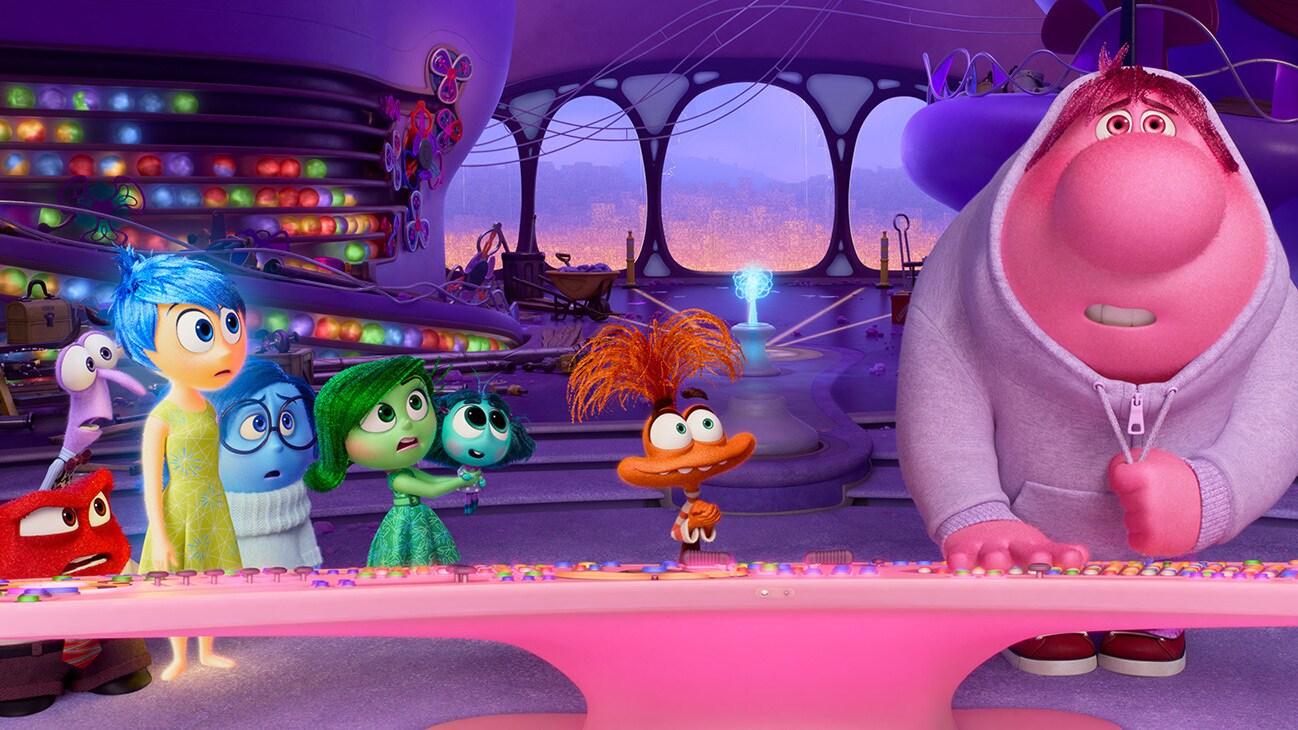
Amongst all other animated movies, ‘Inside Out’ not only stands out due to its new way of telling stories but also for its profound study into the human mind. It was a 2015 release from Pixar Animation Studios that looked at emotions in a very complicated manner, focusing on how an 11-year-old girl called Riley operates internally. As I saw the sequel “Inside Out 2,” in a theatre full of parents, kids, and young adults, it is important to revisit what we learnt in the original film and why it should be watched by teenagers and their parents.
“Inside Out” personifies five primary emotions: Joy, Sadness, Anger, Fear and Disgust. These are the characters that walk with Riley through life’s difficulties especially after her family moved to another city. This movie ingeniously demonstrates this emotional rollercoaster which accompanies such major changes making it relatable for children as well as adults.” Inside Out” helps adolescents who often cope with multiple emotional issues identify and understand that they are real.
Teenagers usually feel overwhelmed by growing up’s flood of emotions. The transformations accompanying the shift from childhood to adolescence are generally confusing and hard to express in words. “Inside Out” addresses these changes by showing that it’s normal to experience a wide range of emotions, sometimes all at once. Riley’s journey teaches teenagers that it’s okay to feel Joy, Sadness, Anger, Fear, and Disgust; these emotions are all part of the human experience.
Among the most touching messages of the film is that one must accept all the emotional states, not only positive ones. Joy, at first, tries to put Sadness aside and believes Riley should always be happy. Eventually however Joy realizes Sadness is vital for Riley’s emotional health. This could be a great revelation for teenagers who are mostly pressured to maintain an image of being ever-happy. “Inside Out” teaches them that it’s okay to feel sad and that acknowledging and expressing this emotion is a crucial part of emotional well-being.
As for parents, “Inside Out” serves as a gentle yet powerful reminder on why empathy and open communication are important in parenting. With our curriculum known for its single-minded commitment towards good grades and high moral standards, mental health has often been pushed aside. This movie indicates that one way of doing this is by understanding the children’s emotions’ needs. Parents can watch Inside out with an aim of learning how they can create an atmosphere where their children will have freedom to express themselves without fear.
The characters’ interactions in Riley’s mind might help parents understand how complex their teenager’s emotional world can be sometimes. As soon as they see that each emotion contributes to Riley’s overall wellbeing, parents may grow more patient and empathetic toward their children’s emotional struggles. This understanding is pivotal in nurturing a child’s emotional health and building a strong, supportive relationship.
“Inside Out 2,” introduces new emotions like Anxiety, Envy, Ennui, and Embarrassment, and makes it clear that the emotional landscape becomes more intricate as children grow into teenagers. The sequel delves deeper into the emotional challenges that accompany adolescence. A memorable scene from the upcoming film features Anxiety taking over from Joy, emphasising the need for more sophisticated emotions to navigate Riley’s more complex life. This transition is a stark reminder that growing up is not just about physical changes but also about evolving emotional needs.
One of the critical aspects of “Inside Out” and its sequel is the portrayal of anxiety. In the sequel, Anxiety explains that Riley’s life now requires more sophisticated emotions. This portrayal can help teenagers and their parents understand that anxiety is not inherently bad. Instead, it’s a natural response to challenging situations. The film can be an essential tool in discussing mental health issues like panic attacks, which are often overlooked in Indian communities.
By presenting anxiety as a part of Riley’s emotional toolkit, “Inside Out 2” can teach teenagers to listen to their inner voice and reassure themselves that everything will be okay, even in difficult situations. This understanding can help them develop healthier coping mechanisms and reduce the stigma associated with anxiety and other mental health issues.
Inside Out is more than just an animated film; it serves as an important resource for teenagers and parents alike. It allows viewers to have a nuanced understanding of emotions; stresses on embracing all feelings and assists them in becoming empathetic as well as encourages open communication. Now that Inside Out 2 has been released and is currently running at theaters across the country, this may be a good time to take the kids to watch the film or to revisit the original movie so that our kids and their guardians can watch it.
Edutainment
A Story About Turning Math Anxiety into Achievement
Published
1 year agoon
June 24, 2024
“Grow up dear and start solving your own problems”.
This popular meme floating on social media always triggers my thinking. It seems to be an age-old way to vent out the stress created by the subject. The last few decades have seen so much shift in the teaching-learning pedagogy, however, the math phobia remains. Researchers have proved that around 50 percent of the population is affected by math anxiety. It is more prevalent in women than in men. Also, it can start as early as age 5 when numbers are being just introduced. Philosophers and thinkers list various reasons for the same. Going through all those reasons I realized that teaching-learning practices are at their core. We need to update them and sync them with needs of the Gen X.
Thus began my journey of unlearning and relearning my math skill. I had to do it for my students, to ensure no stress classroom during math lessons. I started reading, exploring experimenting to have students love the subject. As Math skill will go with them beyond schooling years, for which they need a strong base.
Enters Shriya, whose smile seems to vanish as soon as she heard me say “Let us start with Math now”. Shriya, generally a regular and independent student, who actively took part in various class engagements frequently missed online math lessons. When approached, she very happily would blame it on the net or state some random excuse.
But then started her ordeal of physically being present in my class after the schools reopened post-pandemic. Her parents had already confided in me about her math phobia. Shriya too very innocently stated that “It’s so boring, I cannot even mute the call, close the screen, and have to listen to you”.
“OK Dear!” was my reply. “Let us make the class a little interesting for you. Would you like to give out numbers to classmates to solve?” With a heavy heart, she came forward and picked out the number card and flashed it for her peers to note and start their calculations. While I was busy interacting with other students Shriya sat silently looking at the numbers she had picked. Students around her were busy playing with numbers and trying to solve the given task. Once the class completed the task, we all thanked Shriya for taking those numbers out for us. As the task had turned out to be easy because of that. We collectively decided to make her the star of the day.
I started involving Shriya more and more during the math lesson, giving her responsibilities and involving her in various simple random tasks. To my surprise, Shriya would wait for taking out numbers for the upcoming math lessons. However, as a class rule, we could not give her a chance again, so she decided to sit and be on the other side. I quietly whispered into her years that she could pick her own numbers to do the task. And am glad I did that as she picked up easy numbers to solve the given task. Though she missed out on getting the golden star, which I give out for all correct, I asked her to draw out an ice cream cone for herself for a good attempt. “Do colour the cone with your favourite ice cream flavour” And she smiled.
During the morning circle time, I started with simple math based games, like boom bam, make a sentence, and math magic tricks with students. They really liked it and tried to guess the solution. They started asking friends from other sections and became math magicians. Shriya however still did not have the courage to approach peers as she was not confident with her calculations. So she took the trick home and tried it with her family. She practiced it a couple of times before she confronted them. I was her first audience. Even with her first few fails, I could read her eyes, how much she wanted to taste success here. As a result of emotional learning curriculum being done in school, peers too came forward and supported her. The encouragement she got from there boosted her morale so much that she could not stop talking about it in class.
Then came the concept of fractions where all-time favorite pizza is frequently used as an example. I used stories as a tool to introduce the concept. Students were involved in a follow up activity, which gave them hands-on learning experience of the concept. Once the basics was understood, I moved on to using pizza as an example and every time Shriya would solve fractions properly, I would message her mother, who in turn would cater for a pizza meal.
“My family sat around the table and I had to give one fifth of the pizza to all members”, reported Shriya, the very next day. Great dear, today try eating two thirds of apple pieces at home. I was confident that Shriya would be able to calculate how many pieces of apple to eat, as I had already messaged her mother to cut the apple into six pieces. Shriya was able to make 3 groups of the given apple pieces, but not able to decide how much to eat, so she send me a pic over WhatsApp. I just replied with a guiding question and next minute got a smiling picture with correct apple pieces next to a smiling face.
Shriya then volunteered to take a flip classroom for the next math lesson on fractions. She not only prepared herself for the explanation but also got worksheets ready for her peers. Shriya even gave out stars to all students who deserved them as per her, and in turn, she got the gold star from me. I had to encourage her for her efforts.
Next few concepts, saw Shriya taking a keen interest in the subject and trying her level best. Stumbling at places, this new Shriya did not mind redoing the task. She now had understood that understanding basics were the key to success and that one day she would get the gold star for all correct tasks.
I on my end kept on with my research and tried to make my lesson more engaging, interactive and one with which students could connect with. A mock market was set up in class to practice the concept of money. A number line was made on the floor for understanding decimals. Hopscotch was used for jumping on place values in the international number system. Students played the game of battleship after understanding the coordinates. The class game of Housie was customized to revisit and recap the concepts done. “Who will become the next millionaire” TV show was enacted in my class with a student sitting on the hot seat till they give correct answers to mathematical questions.
Finally came the day, Shriya not only earned her golden star, but it did not stop there, as she was now aiming to get the Math Marshall badge I gave out to students who not only mastered the concept but were ready for peer teaching. And the day she did that, I realized that Math had itself solved its own problem by being supportive in Shriya’s journey from a math hater to a math lover.
Authored By-
Smriti Sajjanhar,
PBL Coordinator,
Bugle Editorial Board, Genesis Global School, Noida
Edutainment
World Theatre Day: Let Theatre Arts Make Classroom’s Showtime Spectacular!
Published
1 year agoon
March 27, 2024
As we roll out the red carpet for World Theatre Day, celebrated every year on March 27, let’s shine the spotlight on the dazzling world of theatre arts in education—a realm where creativity knows no bounds, and every student gets a backstage pass to explore the endless facets of their personality. Theatre arts isn’t just about taking a bow on stage; it’s a grand production that includes acting, scriptwriting, directing, set design, costume creation, and even the magic of lighting and sound effects. It’s where the shy kid in class becomes a roaring lion, and the daydreamer directs their first masterpiece.
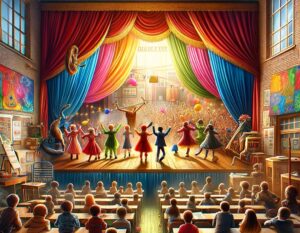
Diving into the eclectic mix that is theatre arts, students embark on a thrilling adventure into storytelling, embodying characters from realms far and wide. But wait, there’s more! Ever fancied crafting a world from scratch? Set design and costume creation offer a canvas for the wildest imaginations, turning dreams into tangible realities. And for the tech-savvy, lighting and sound effects provide the perfect playground to amplify the drama or set the mood. It’s like being the wizard behind the curtain, where a flick of the switch can transport the audience to another dimension.
But theatre arts in schools is more than a ticket to the creative Olympics; it’s a masterclass in life itself. Through the laughter of improvisation and the discipline of rehearsals, students learn the art of expression and the power of voice. Theatre teaches us to walk in others’ shoes, sparking empathy and understanding in a performance that extends beyond the stage and into the corridors of daily life.
And let’s not forget the standup comedians, the jesters of the modern age, who wield humour like a sword, cutting through tension and bringing light to the darkest rooms. Standup comedy, an exhilarating facet of theatre arts, schools students in the art of storytelling and the bravery of vulnerability, proving that sometimes, laughter truly is the best medicine.
Integrating theatre arts into the curriculum is like adding a pinch of magic to the mundane, transforming the classroom into a space where learning is an adventure, not a chore. It’s where students can be themselves (or someone else entirely) in a judgment-free zone, discovering their potential and pushing boundaries, one act at a time. Schools that embrace theatre arts offer students a safe space to explore their identities, confront societal issues, and express themselves authentically. Through theatre, students learn the importance of voice and agency, discovering their capacity to effect change in their communities and beyond.
So, as we celebrate World Theatre Day, let’s champion for theatre arts to take centre stage in schools. After all, in the grand theatre of life, we’re all players, and what better way to prepare for the world’s stage than by embracing the creativity, collaboration, and sheer joy of theatre arts? Here’s to the scriptwriters, the directors, the set designers, and the stars of tomorrow—may your light shine bright, both on and off the stage.
In the immortal words of Shakespeare, “All the world’s a stage,” and it’s high time we all play our part, ensuring that the wonders of theatre arts are not just an act, but a fundamental chapter in the story of education.
Education
Lessons Beyond a Cricket Pitch: An IPL-Inspired School Curriculum
Published
1 year agoon
March 27, 2024
“As we tune into the electrifying atmosphere of the Indian Premier League, where the clash of willow against leather sends pulses racing, we’re not just spectators of a thrilling spectacle. We’re witnesses to a living, breathing classroom where science dances with agility, leadership commands the play, and economics paints the bigger picture. Today, let’s embark on a journey beyond the boundary ropes, exploring how the IPL isn’t merely a cricket tournament but a dynamic, fun-filled educational odyssey.”
The Science Behind the Ball and Bat
At the heart of cricket lies a ballet of physics, each ball bowled a lesson in motion, energy, and force. The journey of a cricket ball, from the bowler’s hand to the bat, is a vivid demonstration of aerodynamics in action. Factors like air resistance, spin, and the Magnus effect collaborate to dictate the ball’s trajectory. A spinner’s delivery, curving through the air, isn’t just a challenge for the batsman but a practical example of physics. The materials of the game, especially the cricket bat made from willow, offer insights into material science, chosen for their capacity to absorb the shock of the ball’s impact and minimize damage to the hands.
The biomechanics of players, whether it’s a batsman executing a perfect cover drive or a bowler’s seam position at the point of delivery, are a testament to the human body’s potential when understood and harnessed through the principles of physics. Integrating these aspects into the curriculum can transform a standard physics lesson into a riveting session that connects students’ passion for cricket with the wonders of science.
Leadership on and off the Pitch
The IPL is a crucible of leadership, each match a case study in strategy, decision-making, and human management. Players like Virat Kohli and Rohit Sharma, with their tactical acumen and ability to inspire their teams, embody the essence of effective leadership. “Sports has taught me a lot. It helps reveal character. Sport teaches you about facing challenges, overcoming challenges on a regular basis which apply to every work of life.” Kohli once remarked, encapsulating the spirit of sportsmanship that transcends the cricket field. This philosophy can seamlessly be integrated into educational discussions, illustrating how leadership isn’t confined to high-pressure matches but is equally relevant in group projects, student councils, and beyond. MS Dhoni, a legendary cricketer and former Indian cricket team captain also believes that it is important to push every youngster to take up sports. “Be it, mentally or physically, sport teaches a lot to the students and that actually helps in practical life. Sports should play a big role in students’ life and everyone should be pushed to it,”
The Economy of Runs and Rupees
The IPL, a dazzling spectacle of cricket, is also a multi-billion-dollar industry that serves as a fascinating model for financial literacy and understanding the global economy of sports. The auction room, where players are bid on like prized artworks, offers a live demonstration of market dynamics and valuation. Sponsorships, media rights, and merchandising around the IPL introduce students to concepts of branding, revenue generation, and the economic impact of sports on national and global scales. It’s a practical lesson in economics, illustrating how supply and demand, investment, and financial management play out in one of the world’s most popular sports leagues.
IPL: A Classroom Without Walls
The IPL’s fusion of high-stakes cricket with lessons in physics, leadership, and economics presents an unparalleled opportunity to make learning interactive and engaging. It encourages students to see the relevance of their studies in real-world scenarios, thus igniting a passion for subjects that might previously have seemed abstract or disconnected from their interests.
Incorporating IPL-themed lessons into the curriculum can transform the traditional classroom, making learning a lively, participatory experience. As students analyse match strategies, calculate batting averages, or explore the economic model of the IPL, they’re not just learning; they’re engaging with the material in a way that’s both meaningful and enjoyable.
Cricket commentator and former cricketer Ian Bishop‘s words resonate deeply here: “The heart and soul of the game is what makes it so special.” In the context of education, the IPL embodies this spirit, proving that when you blend passion with learning, the classroom becomes a place of endless possibilities and discoveries.
The Indian Premier League offers more than just entertainment. It provides a vibrant, multifaceted platform for learning, encompassing physics, leadership, and economics, among other subjects. By viewing the IPL through an educational lens, we can inspire students to engage deeply with their studies, showing them that education, like cricket, can be filled with excitement, challenges, and lifelong lessons.
Newsletter

Less Than Half of Indian Schools Offer Skill-Based Courses for Senior Students: NCERT Survey

The Woman Who Refused to Disappear – Aditi Sharma’s Quiet Fight for Education

A Vision Beyond Sight – How Aarti Takawane is Rewriting Futures for Blind Girls

UP Govt Launches Astro Labs in Government Schools to Boost Scientific Learning

Class 3 Learning Levels Show Gains Since Pandemic, But Still Below 2017: PARAKH Survey

Design and the Future of Learning: How Architecture is Shaping Next-Gen Schools

Punjab to Introduce Business, Marketing Education in Govt Schools for High Schoolers

Manipur Rallies Call for Disruption-Free Education Amid Ongoing Unrest

Tripura CM Launches School Framework, Stresses Social Work in Education

“We Sleep on Walls Here”: Shubhanshu Shukla Talks to Indian Students from Space

A Structural Proposal to Transform School Education in Bihar

NIIT Foundation and YuWaah, UNICEF Launch Free Online Digital Marketing Course for Youth

National Conference Pushes for Common Standards Across School Boards

Maharashtra: Over 8,000 Villages Lack Schools, CCTV Compliance Still Patchy

Haryana to Offer Free After-School Coaching for JEE, NDA Aspirants

Telangana CM Calls for Overhaul of Intermediate Education in Telangana

Indian Astronaut Shubhanshu Shukla to Connect with School Students Live from Space

Are 4-Year Degrees Dead? Nikhil Kamath and the WEF Say Lifelong Learning Is Here to Stay

UGC Cracks Down on 89 Institutes Over Anti-Ragging Failures

Government Doubles Down on Coaching Centres: New Panel Signals Stronger Regulation Ahead

CBSE To Conduct Board Exams Twice for Class 10 from 2026

How to Win Back Wandering Minds: Post-Summer Edition
Tripura Becomes Third Indian State to Achieve Full Literacy

Assam Brings Sign Language to Senior Secondary Classrooms in Landmark Move

Delhi Schools to Implement Age 6 Rule for Class 1 Admissions from 2026

Is Your School Following These Mandatory CBSE Committees?

CBSE’s ‘Sugar Boards’ Initiative: Tackling the Sweet Crisis in Indian Schools

Maharashtra to Regulate Pre-Primary Education with New Law Aligned to NEP 2020

MAHAJYOTI’s Book Distribution Scheme to Empower 7,000 OBC Students Preparing for JEE/NEET & MHT-CET

China Embarks on Ambitious AI-Driven Education Reform to Build a ‘Strong Education Nation’ by 2035

John King’s Book ‘Teacher By Teacher’: A Global Tribute to the Transformative Power of Education

CBSE Introduces Mandatory Bridge Course for Classes 6 to 12 in Chhattisgarh Under NEP 2020

Rewriting Ambedkar: Why Students Must Know the Man Beyond the Constitution

CBSE Mandates 50-Hour Annual Training for Teachers, Declares STEM as 2025 Theme

Banu Mushtaq’s International Booker Win Is a Wake-Up Call for Indian Schools to Reclaim Literature

India Bids Farewell to NEP Architect Dr K. Kasturirangan

Pradhan Mantri Rashtriya Bal Puraskar 2025: Nominations Now Open for India’s Young Achievers

NCERT Class 7 Textbooks Updated: Mughals Removed, Focus on Indian Ethos and Pilgrimage

Delhi Government Cracks Down on Dummy Schooling; Over 600 Schools Inspected, 10 Issued Notices

Delhi Approves Landmark Bill to Regulate School Fees Across 1,677 Institutions

Operation Sindoor and Operation Abhyaas: Navigating School Safety and Student Well-being Amid Rising Tensions

Harvard Stands Its Ground: Harvard Faces ₹18,400 Crore Funding Freeze After Rejecting Trump Administration’s Demands

CUET-UG 2025 Likely to be Postponed, Fresh Dates Expected Soon

Aalamaram 2025: Where Indian Educators Came Together to Grow, Reflect, and Lead

Trump Signs Executive Order to Promote AI Integration in U.S. K-12 Education

Mizoram Declared First Fully Literate State in India

Indian Students Flock to Singapore, Ireland, and Dubai for Higher Studies: 38% Surge Recorded

OpenAI Academy Launches in India to Democratise AI Education for Students, Teachers, and Startups

UK’s New Immigration Rules: What They Mean for Indian Students

Private School Fees Surge by 50–80% in Three Years, National Survey Finds
SGEF2023 | Special Address by Rama Datt, Trustee, Maharaja Sawai Man Singh II Trust, Jaipur

ScooNews | After Movie | ScooNews Global Educators Fest 2023

Aftermovie | NIES2 UP Chapter | 21 Jan 2023

WEBINAR | Gamification in Education: How Digital Badges Can Boost Student Motivation and Engagement

ScooNews | WEBINAR| Importance of Physical Activity for Children at School | Plaeto

SCOONEWS | WEBINAR | WHY DIGITIZING YOUR SCHOOL IS A MUST | TEACHMINT

Keynote Address | Lakshyaraj Singh Mewar

Anurag Tripathi, Secretary, CBSE at SGEF2022

How schools can nurture every student’s genius

Aftermovie | SGEF2022 | Jaipur

Li Andersson | Minister of Education | Finland

Anurag Tripathi, Secretary, Central Board of Secondary Education (CBSE) discusses NEP2020

ScooNews | Early Ed Asia 2019 | Aftermovie
#PodarECEconf : Pursuing quality ECE

#CBSE Class XII #Results #Highlights

The interesting story of India’s educational system | Adhitya Iyer

A young scientist’s quest for clean water

The Danger of Silence: Clint Smith

National Digital Library of India is an initiative by HRD Ministry

Remembering Kalpana Chawla on her birthday!

Message from Sadhguru for Students!
Message from Sadhguru for Students!

The Untapped Genius That Could Change Science for the Better

Eddy Zhong: How school makes kids less intelligent TEDxYouth@Beacon

#TEDxCanberra : What if every child had access to music education…
Trending
-

 Education3 months ago
Education3 months agoIs Your School Following These Mandatory CBSE Committees?
-

 Education2 months ago
Education2 months agoCBSE’s ‘Sugar Boards’ Initiative: Tackling the Sweet Crisis in Indian Schools
-
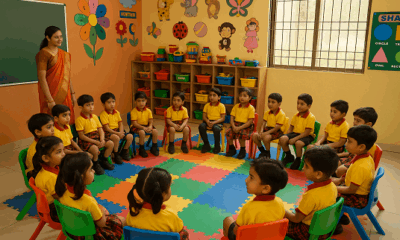
 Education3 months ago
Education3 months agoMaharashtra to Regulate Pre-Primary Education with New Law Aligned to NEP 2020
-

 Education3 months ago
Education3 months agoMAHAJYOTI’s Book Distribution Scheme to Empower 7,000 OBC Students Preparing for JEE/NEET & MHT-CET
-

 Education3 months ago
Education3 months agoChina Embarks on Ambitious AI-Driven Education Reform to Build a ‘Strong Education Nation’ by 2035
-
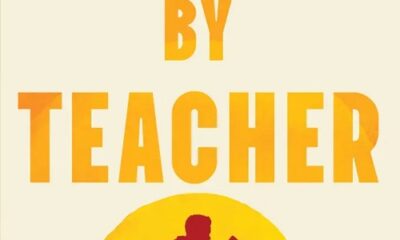
 Education2 months ago
Education2 months agoJohn King’s Book ‘Teacher By Teacher’: A Global Tribute to the Transformative Power of Education
-
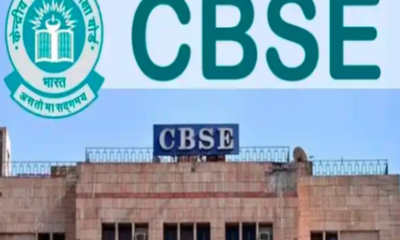
 Education3 months ago
Education3 months agoCBSE Introduces Mandatory Bridge Course for Classes 6 to 12 in Chhattisgarh Under NEP 2020
-
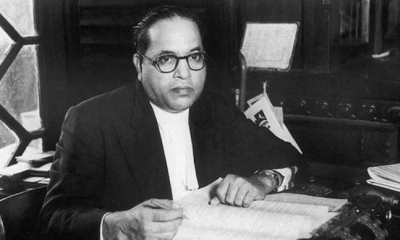
 Education3 months ago
Education3 months agoRewriting Ambedkar: Why Students Must Know the Man Beyond the Constitution
-
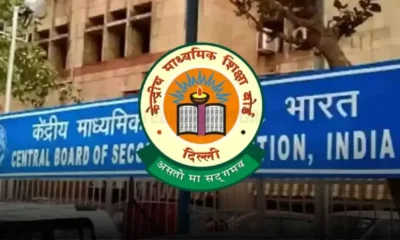
 Education3 months ago
Education3 months agoCBSE Mandates 50-Hour Annual Training for Teachers, Declares STEM as 2025 Theme
-
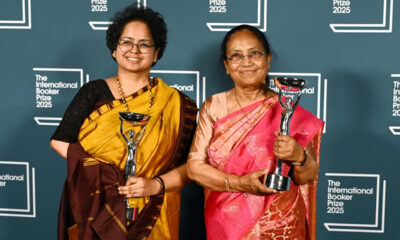
 Education2 months ago
Education2 months agoBanu Mushtaq’s International Booker Win Is a Wake-Up Call for Indian Schools to Reclaim Literature





